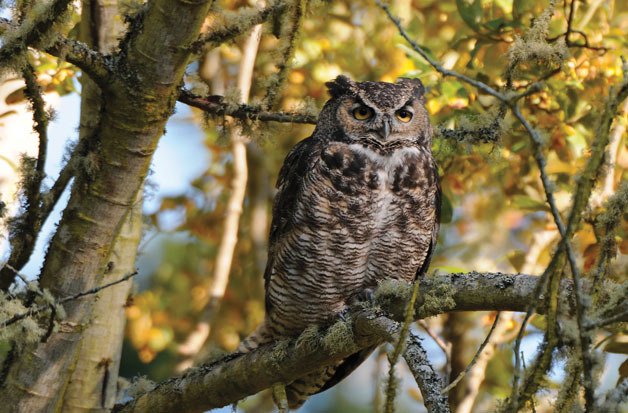Note to readers: With this column I begin a collaboration with one of Whidbey Island’s best bird photographers, Craig Johnson. Please let us know what you think of the results.
A couple weeks ago I returned from the East coast and awakened very early, a result of jet lag. I pulled on a warm robe and stepped outside in the dark and listened. Through the still air I heard a Great Horned Owl calling, hoo, hoo-hoo, hoo, hooo sometimes interpreted as “Who’s awake, me too.”
A pair of owls called to each other, the female’s hoot in a slightly higher range. I know that they often roost in a tall dead snag to the north of our house and I could just barely make out the shape of this large, majestic, ear-tufted creature. I couldn’t see the prominent facial disk and large golden eyes illustrated in Craig’s photo.
Then it flew soundlessly across the lawn in front of me, reflecting the light from inside the house and disappeared off into the trees to the south.
I listened but didn’t hear the calls and shrieks of the juvenile owls, those born late last winter. These young owls accompany their parents through spring and most of the summer begging for food and learning how to hunt for themselves.
As I waited the owls resumed their hooting, but not enthusiastically. They will ramp-up their vocal courtship later this month, usually around Halloween.
Although I find the hooting of owls comforting, I’m aware that is not always the case. About 10 years ago, my husband and I found ourselves in a small Bolivian village on an island in Lake Titicaca. Most of the people in this remote area were of an indigenous culture and tended terraced fields growing various kinds of beans, especially lima beans.
One evening we arrived back at our guesthouse just after the sun had set and noticed a group of farmers gathered in the street talking anxiously. They spoke an indigenous language, but our English-speaking guide knew their language and translated for us.
Several of the men carried slingshots and before we could figure out what was happening someone fired his slingshot into the air. I heard a ping and looked up at a dead tree to see a beautiful Great Horned Owl lift off the snag and fly away.
Our guide later explained that the owl symbolized death and none of the farmers wanted the owl near their houses. They were intent on killing it.
Within the avian community, Great Horned Owls are not particularly popular either. As with most large raptors, the smaller birds try to scare them away from their nesting territories. Not with slingshots but with a tactic called mobbing.
Crows, jays, robins and even smaller birds will gather into groups and dive bomb the owl over and over again, hoping to send it on its way. Photographer Craig Johnson has even seen hummingbirds involved in this behavior.
This month listen and watch for owls. Not only the Great Horned Owls but also the Barred Owls — “Who-cook’s-for-you?” — and Barn Owls — hisses and screeches — will be calling. And by next month the tawny Short Eared Owls and the very reclusive Northern Saw-whet Owls will retreat from colder climes and quietly spend the winter with us.
Frances Wood can be reached at wood@whidbey.com. Email Craig Johnson at Craigjohnson@whidbey.com


